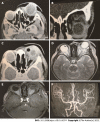Globe luxation may prevent myopia in a child: A case report
- PMID: 35663058
- PMCID: PMC9125280
- DOI: 10.12998/wjcc.v10.i14.4574
Globe luxation may prevent myopia in a child: A case report
Abstract
Background: Globe luxation is rare and is mostly due to direct orbital trauma with fractures of the medial and floor walls, which displace the globe into the maxillary sinus. Only a few cases have been reported; moreover, patients who suffer global luxation rarely achieve eyesight recovery.
Case summary: This report describes the treatment and prognosis of global luxation occurring in a child. A 6-year-old boy presented with left globe luxation that occurred after a sudden stop on a tricycle, without any injury to the orbital or maxillofacial bony structures. After admission to the hospital, an external canthus incision, globe repositioning, orbital exploration and temporary blepharoplasty were performed. Finally, the child completely recovered and maintained good eyesight in his left eye even though the right eye developed myopia after four years of follow-up.
Conclusion: The aim of this study was to report the special occurrence of globe luxation in the child and share some experience of the treatment. Immediate surgical management plays an important role in the recovery of visual function, and globe luxation may prevent nearsightedness by reducing the distortion of the eyeball, shortening the axis and improving ciliary function.
Keywords: Case report; Globe luxation; Myopia; Orbital trauma.
©The Author(s) 2022. Published by Baishideng Publishing Group Inc. All rights reserved.
Conflict of interest statement
Conflict-of-interest statement: The authors declare that they have no conflicts of interest.
Figures


References
-
- de Saint Sardos A, Hamel P. Traumatic globe luxation in a 6-year-old girl playing with a tube of wrapping paper. J AAPOS. 2007;11:406–407. - PubMed
-
- Ramstead C, McCabe J, Alkahtani M, Leong-Sit J, Morhart M. Traumatic dislocation of the globe into the maxillary sinus. Can J Ophthalmol. 2008;43:364–366. - PubMed
-
- Müller-Richter UD, Kohlhof JK, Driemel O, Wagener H, Reichert TE. Traumatic dislocation of the globe into the maxillary sinus. Int J Oral Maxillofac Surg. 2007;36:1207–1210. - PubMed
-
- Haggerty CJ, Roman P. Repositioning of a traumatically displaced globe with maxillary antrostomy: review of the literature and treatment recommendations. J Oral Maxillofac Surg. 2013;71:1915–1922. - PubMed
Publication types
LinkOut - more resources
Full Text Sources

